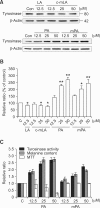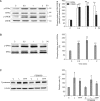Lotus (Nelumbo nuficera) flower essential oil increased melanogenesis in normal human melanocytes
- PMID: 19322028
- PMCID: PMC2721149
- DOI: 10.3858/emm.2009.41.7.057
Lotus (Nelumbo nuficera) flower essential oil increased melanogenesis in normal human melanocytes
Abstract
In this study, the essential oil from lotus flower extract, including petals and stamens, was assessed with regard to its effects on melanogenesis in human melanocytes. The lotus flower essential oil was shown to stimulate melanin synthesis and tyrosinase activity in a dose-dependent manner. The lotus flower essential oil induced the expression of tyrosinase, microphthalmia-associated transcription factor M (MITF-M), and tyrosinase-related proten-2 (TRP-2) proteins, but not tyrosinase mRNA. Moreover, it increased the phosphorylation of ERK and cAMP response element binding protein (CREB). In order to verify the effective components of the lotus flower oil, its lipid composition was assessed. It was found to be comprised of palmitic acid methyl ester (22.66%), linoleic acid methyl ester (11.16%), palmitoleic acid methyl ester (7.55%) and linolenic acid methyl ester (5.16%). Among these components, palmitic acid methyl ester clearly induced melanogenesis as the result of increased tyrosinase expression, thereby indicating that it may play a role in the regulation of melanin content. Thus, our results indicate that lotus flower oil may prove useful in the development of gray hair prevention agents or tanning reagents.
Figures



References
-
- Ando H, Itoh A, Mishima Y, Ichihashi M. Correlation between the number of melanosomes, tyrosinase mRNA levels, and tyrosinase activity in cultured murine melanoma cells in response to various melanogenesis regulatory agents. J Cell Physiol. 1995;163:608–614. - PubMed
-
- Ando H, Watabe H, Valencia JC, Yasumoto K, Furumura M, Funasaka Y, Oka M, Ichihashi M, Hearing VJ. Fatty acids regulate pigmentation via proteasomal degradation of tyrosinase: a new aspect of ubiquitin-proteasome function. J Biol Chem. 2004;279:15427–15433. - PubMed
-
- Bertolotti A, Melot T, Acker J, Vigneron M, Delattre O, Tora L. EWS, but not EWS-FLI-1, is associated with both TFIID and RNA polymerase II: interactions between two members of the TET family, EWS and hTAFII68, and subunits of TFIID and RNA polymerase II complexes. Mol Cell Biol. 1998;18:1489–1497. - PMC - PubMed
-
- Bi Y, Yang G, Li H, Zhang G, Guo Z. Characterization of the chemical composition of lotus plumule oil. J Agric Food Chem. 2006;54:7672–7677. - PubMed
-
- Borgi W, Bouraoui A, Chouchane N. Antiulcerogenic activity of Zizyphus lotus (L.) extracts. J Ethnopharmacol. 2007;112:228–231. - PubMed
Publication types
MeSH terms
Substances
LinkOut - more resources
Full Text Sources
Other Literature Sources
Miscellaneous
